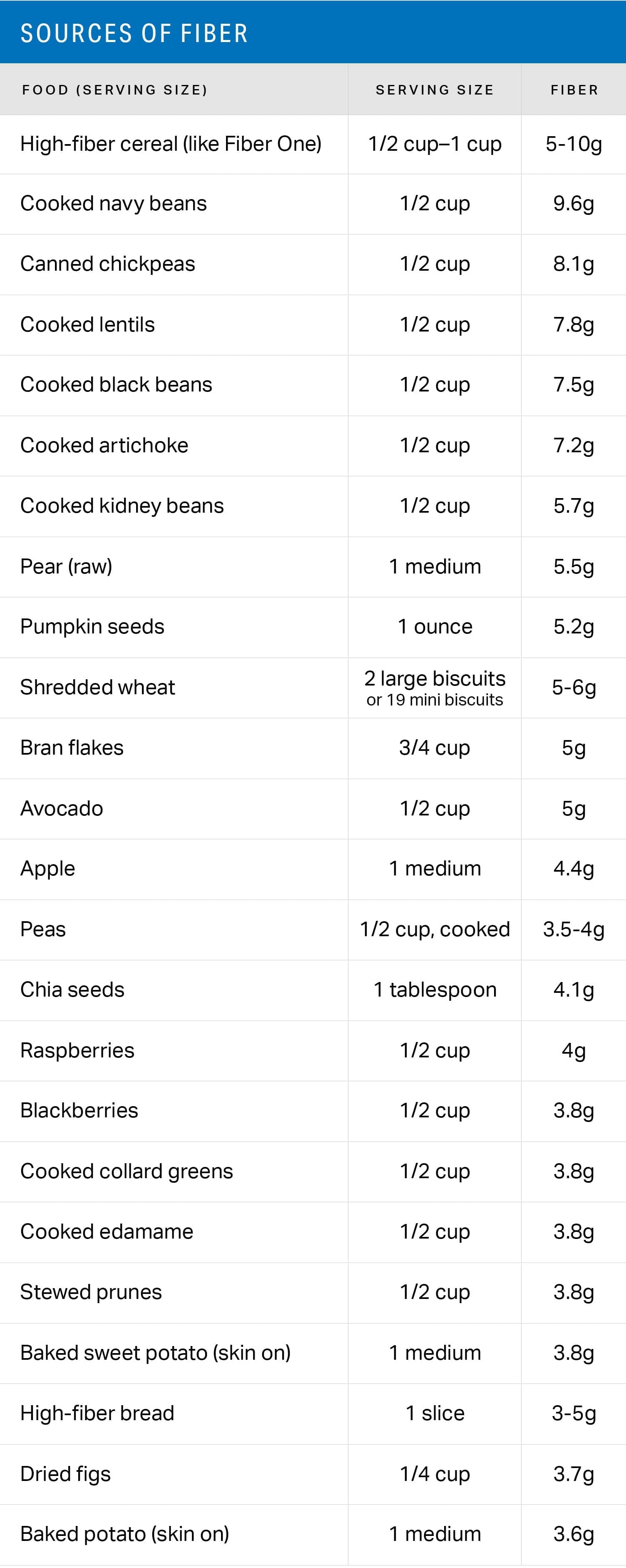Compared to protein or omega-3 fatty acids, fiber may not always be the most exciting topic in the world of nutrition. It’s a really important one, though.
Because most of us eat so little fiber, it’s been a “nutrient of concern” according to the USDA since 2005.
And there’s every reason to be concerned about fiber. Only about 5% of Americans meet the minimum recommended daily fiber requirements.
The average North American only eats about 17 grams per day when they need more like 25 to 35 grams.
The list of reasons why fiber is a must for good health is long.
For starters, it helps control blood sugar, protects your heart, helps decrease risk of colorectal cancer, helps your reach and maintain a healthy body weight, and has been shown to lower your risk of mortality.
If all this has you saying “pass the oatmeal,” we understand.
Here’s what you need to know about dietary fiber and how to make sure you get enough in your daily diet.
Understanding Dietary Fiber
In a nutshell, dietary fiber is a type of carbohydrate that our bodies can’t fully digest. It’s found in plant-based foods.
Unlike sugars, fats, and proteins, fiber passes through our system mostly intact. But even though we can’t break it down to use for energy, high-fiber recipes do a whole bunch of good stuff inside us.
Soluble vs Insoluble Fiber: Know the Difference
Now, what is the role of fiber? There are two main types of fiber: soluble and insoluble. While both are important, they work in different ways.
Soluble fiber—found in oats, barley, beans, lentils, peas, apples, and citrus fruits—acts like tiny sponges in your digestive system. When it comes into contact with water, it soaks it up and forms a gel-like substance that:
- Slows down sugar absorption. Soluble fiber helps prevent blood sugar spikes, which is great for folks with type-2 diabetes or anyone who wants to keep their energy levels steady.
- Lowers bad cholesterol. Soluble dietary fiber prevents cholesterol particles from sticking around. Eating 5-10 grams or more can help lower your low-density lipoproteins (LDL) and improve your heart health.
- Increases satiety. The gel formed by dietary-fiber-rich foods can make you feel full for longer. This can be helpful for managing weight.
The insoluble fiber in foods, on the other hand, doesn’t dissolve in water. It passes through your gut pretty much as it enters your body.
It’s like a natural broom for your intestines that helps you move things along, helping with constipation. You can find it in whole grains, legumes, and vegetables—especially leafy greens and roots.
Health Benefits of Fiber
Fiber is an essential part of a healthy diet and offers a huge variety of health benefits. Meeting your daily fiber requirements may help:
- Promote the growth of gut-friendly microflora
- Enhance your immune system
- Prevent blood sugar spikes
- Keep cholesterol levels under wraps
- Reduce the risk of heart disease
- Lower your chances of getting type 2 diabetes
As a recent study shows, eating more fiber may even help you lose a some weight.
Types of Fiber
It’s easy to overestimate the amount of fiber you get in a day. Some people eat a side salad or an apple, and cross fiber off their list of things to eat today.
To get the amount of fiber you need, you’ll want to include a variety of fiber rich foods throughout your day.
Here’s a breakdown of what foods to include in your meals to reach your daily fiber requirements:
- Legumes: Legumes include beans, lentils, chickpeas, soybeans, and peas. A single cup of cooked lentils can provide over 15 grams of fiber.
- Fruits: Berries, pears, apples, and other fruits are high in fiber. A medium apple with the skin on has about 4.5 grams of fiber.
- Vegetables: Artichokes, Brussels sprouts, broccoli, and many other vegetables are all high in fiber. A medium-sized avocado, for example, has over 13 grams of fiber.
- Whole grains: Brown rice and quinoa are excellent choices to up your daily fiber intake. A cup of cooked quinoa provides about 5.2 grams of fiber.
- Nuts and seeds: Almonds, chia seeds, pistachios, and sunflower kernels, are all high in fiber. A quarter cup of almonds has about 3.5 grams.
When you go food shopping, don’t forget to check the nutrition labels. You won’t find the same fiber content in white bread as in whole-grain bread, for example.
Knowing how much fiber each item in your cart has will help you make better choices to make sure you’re eating enough dietary fiber-rich foods.

How Much Fiber Do You Need Per Day?
Adults need a bare minimum of 21 to 38 grams of fiber, depending on age and gender, to keep your body happy and healthy.
To fulfill your daily fiber requirements, the Institute of Medicine (IOM) recommends the following daily intake:
- Children: 19-25 grams per day
- Women: 21-26 grams per day
- Men: 30-38 grams per day
Also Read: Are You Eating Enough Fiber? Get Your Fiber Score
What Does a Full Day of Fiber Look Like?
Getting to your minimum daily fiber requirements may feel a bit daunting if you’re new to the territory. The good news is that it’s not rocket science.
So, what does 30 grams of fiber look like? Here’s a sample meal plan that adds up to more than 40 grams of fiber for the day:
Breakfast
- 1/2 cup rolled oats cooked with water or plant-based milk (8g)
- 1 cup berries (7g)
- 1/4 cup chopped almonds (3g)
Lunch
A big salad with:
- 2 cups mixed greens (.8g)
- 1 cup cooked chickpeas (13g)
- 1/2 cup chopped carrots (1.7g)
Dinner
- Salmon with 1 cup of roasted brussels sprouts (6g)
- 1 cup quinoa (5g)
Of course, you can adjust portion sizes and ingredients based on your preferences. If you need a hand calculating how much fiber you eat, using a nutrition and food tracking app like MyFitnessPal might be your best bet.
Also Read: 8 High-Fiber Meals That Support Weight Loss
Frequently Asked Questions
How do I make sure I have enough fiber?
Add fiber-rich foods to your plate every chance you get. Reach for fruits, vegetables, whole grains, and beans. Keep a food diary or use the MyFitnessPal app to track your intake and watch your grams of dietary fiber add up.
What are signs or symptoms of not enough fiber?
Considering 95% of Americans aren’t getting enough fiber, you probably don’t need a sign to know you need to eat more fiber. But if you ever struggle with constipation, that’s a hint you could probably use more fiber.
How do I make sure I’m meeting my protein goals and getting enough fiber without going over my calorie goal?
Smart choices make this totally doable, according to Katherine Basbaum, Registered Dietitian, MyFitnessPal. “Incorporate high-fiber, low-calorie vegetables like broccoli, spinach, and carrots into your meals,” she says. When you can, opt for fiber-rich whole grains over refined grains. To meet protein and fiber goals at the same time, Basbaum recommends including beans and lentils. “They’re high in fiber and also offer protein to keep you full,” she says. For snacks opt for lower calorie options like apples and berries.
Can I get too much fiber?
Some people overdo it when they switch to a high-fiber diet. They try to increase fiber too quickly, which can lead to gas, bloating, and cramps. So take it slow and ramp up the amount of fiber you eat gradually. Janese Laster, MD, and MyFitnessPal Scientific Advisory Council member recommends increasing your fiber intake by 5g per week until you hit 25g (for women) or 38g (for men).
Should I take a fiber supplement?
With any supplement, you need to talk to your doctor. If you’re truly unable to meet your fiber needs through diet alone, a supplement could be helpful. Your doctor can help you choose the right type of fiber and amount for your specific situation.
Originally published January 9, 2019; Updated July 22, 2024





